
Kidding--no doom is involved. Why does everyone cower in fear and confusion when a blank mixing chart appears? Please don't cower! It's a simple grid with the same 6 paint color names written along each axis. And I am going to walk you through it. Here, hold my hand.

The top left square (column 1, row 1) represents the intersection of White and White. Because I am using watercolor paints this morning for the demonstration, the paint color White will be played by the white watercolor paper. If you are using watercolor paint, leave this square blank. If you are using acrylic or oil paint, please use your White paint to fill in the top left square.
The square immediately below that (column 1, row 2) represents the intersection of Yellow (see the name to the left) and White (see the name at the bottom of the column). Does that make sense? If you are using watercolor paint, fill in this square with very diluted Yellow. If you are using acrylic or oil paint, mix Yellow with White and fill in this square with that mixture.
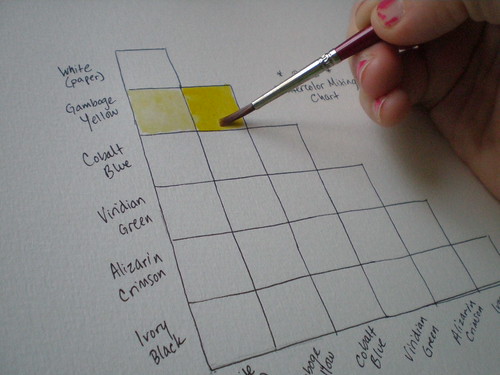
The square to the right of that one (column 2, row 2) represents the intersection of Yellow (look left) and Yellow (look below). Please fill this square in with Yellow.

Moving down to the third row... The first square (column 1, row 3) represents the intersection of Blue (look left) and White (look below). If you are using watercolor paint, fill in this square with very diluted Blue. If you are using acrylic or oil paint, mix Blue with White and fill in this square with that mixture.
The square to the right (column 2, row 3) represents the intersection of Blue (look left) and Yellow (look below). Mix Blue and Yellow and fill in this square with that mixture.
The next square to the right (column 3, row 3) represents the intersection of Blue and Blue. Fill in this square with Blue.
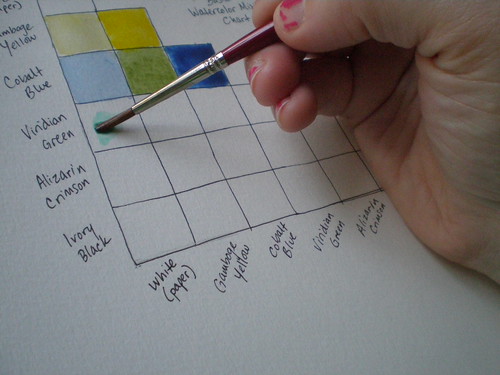
Next move onto the Greens in row 4. Carefully look to the name on the left of the row and the bottom of the column for each square:
Row 4 + column 1 = Green + White
Row 4 + column 2 = Green + Yellow
Row 4 + column 3 = Green + Blue
Row 4 + column 4 = Green + Green
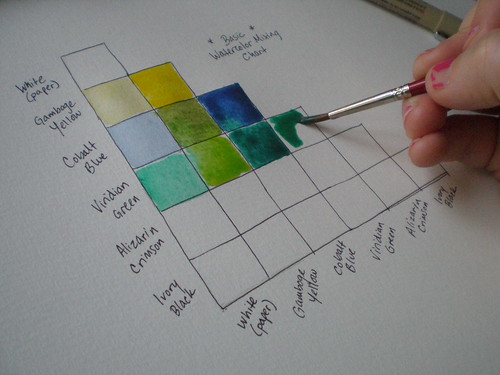
Are you getting the hang of it now? I realize am being very specific and repetitive, but it's only for the sake of clarity. I have seen more than one painter tear out their hair trying to put together a decent mixing chart. And it's a shame because the chart is such a useful tool when it's complete.
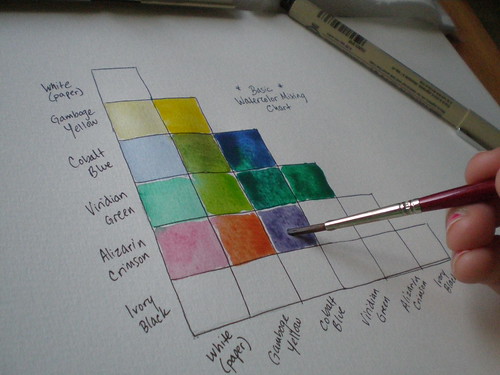
Now onto the Reds:
Row 5 + column 1 = Red + White
Row 5 + column 2 = Red + Yellow
Row 5 + column 3 = Red + Blue
Row 5 + column 4 = Red + Green
Row 5 + column 5 = Red + Red

And finally:
Row 6 + column 1 = Black + White
Row 6 + column 2 = Black + Yellow
Row 6 + column 3 = Black + Blue
Row 6 + column 4 = Black + Green
Row 6 + column 5 = Black + Red
Row 6 + column 6 = Black + Black
It doesn't need to be pretty, only practical.
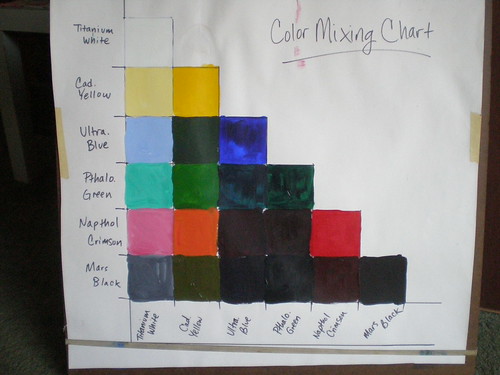
Here's the huge one I made--battle scars and all--when I taught acrylic painting classes a few years ago. All of the paint names are a little different, but it's the same 6 core colors. You can make your chart with as many squares as you need so that it includes every color in your arsenal. But the Mixing Chart is a great quick reference tool if you want to see how each of your paint colors interacts with the each of the others. Hope this is helpful!

No comments:
Post a Comment